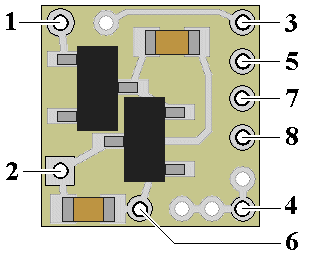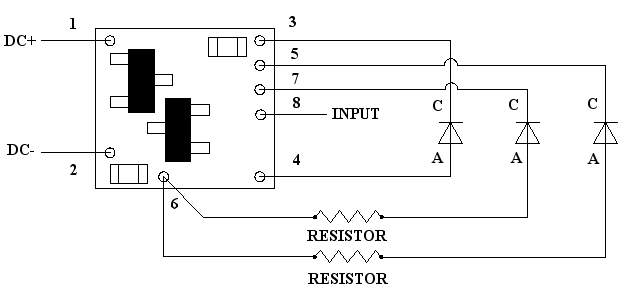Best viewed using:
Internet Explorer
or
Mozilla Firefox
Connecting the N8043 Universal Strobe Simulator
Installing the N8043 is very straightforward. Its tiny size and thin construction will allow it to be placed nearly anywhere in any scale model. Because the module has circuitry on both sides, care must be taken to be sure that the components or wires soldered will not make contact with any metal object causing a short circuit.
The N8043 can be powered by battery or any well-filtered and regulated DC power source with an output of 6-18VDC.
Included with the module are three 6” lengths of #32 insulated wire. If necessary, these can be used for power input and function control wires.

Figure 1
Important note: A low-wattage iron with a pointed tip should be used for connection of wires. Too much heat or solder can easily damage the wires, decoder or module and void the warranty.
Also, all connecting wires should be pre-tinned before soldering them to the module. This will make connection quick and easy and ensure excessive heat is not applied to the solder points.
Connecting LEDs
When connecting the LEDs, proper polarity must be observed. LEDs are “polarity sensitive” and will not function if connected backwards. The N8043 is configured to allow the connection of up to three (3) 20 ma LEDs. Since most strobe lights are white in color, this simulator's on-board resistor (the resistor for the LED to be connected between solder points 3 & 4), is to provide current protection for a white LED with a device voltage of 3.3-3.6 VDC. This covers Ngineering’s 2x3, Micro and Nano white LEDs, as well as many white LEDs available.
Using wire appropriate for the size of the LED and its placement in the locomotive, connect the LED cathode (the – connection) to point #3 on the module and connect the LED anode (the +) to solder point #4. Again, this LEDs will use the on-board current limiting resistor so it can be wired directly.
The N8043 is configured to support two (2) additional LEDs for a total of three (3). Each additional LED must be wired with an external resistor in series to limit the current flow through the LED. Included with this module are several 1/8-watt surface-mount resistors. There are two 81Ω resistors (plus a spare) if the additional LEDs are to be white in color, and one 150Ω resistor (plus a spare) for a red or yellow LED (some strobes are red or amber). These resistors are tiny for easy placement and have pre-tinned tabs so soldering is easy. The second LED’s cathode is to be wired to solder point 5 on the module. The resistor should be wired in series between this LED’s anode and point 6. The third LED's cathode is to be wired to solder point 7 on the module. The resistor should be wired in series between this LED’s anode and point 6. See Fig. 2 below for a complete overview of wiring.
Strobe Timing
The N8043 will control strobe effects for 3 LEDs. With the input pin (solder point 8) left disconnected, output pins 3, 5 & 7 all flash together simultaneously at a rate of once/second. When the input pin is grounded (DC-), LEDs connected to outputs 3 & 5 continue to strobe together at once/second, but output 7 strobes alternately with 3 & 5. The alternating rate is once every 1/2 second (output 7 pulses in between the pulses of 3 & 5). This feature allows various combinations of strobe effects, depending on number of LEDs, LED color and input grounding. Please see Examples of use for applications and more detail.

Figure 2
Once again, be sure to use a low-wattage soldering iron when connecting wires to the module. Our N40M2 12-watt Iron with either the N408I (iron clad) Needle Tip, or the N408X (bare copper) Needle Tip would be an excellent choice for this operation.
Input control
Solder point 8 can be connected to any switch (momentary pushbutton or magnetic reed switch) which is tied to -DC (ground).
This completes hookup of our N8043 Universal Strobe module. We hope the added realism it provides enhances your enjoyment of the hobby.
© 2008 Ngineering





















